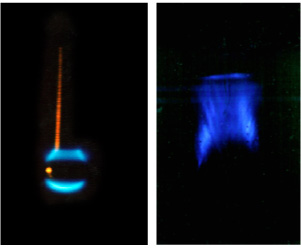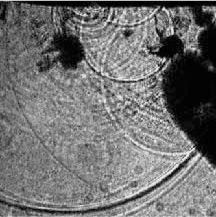ASA/NOISE-CON 2000
![]()
![]()
![]()
[ Lay Language Paper Index | Press Room ]
Sonoluminescence at the Nano-Scale--
and Its Connection to Ultrasound-Assisted Liposuction
Carlos G Camara - 310-825-1242, camara@physics.ucla.edu
Keith R Weninger
Seth J Putterman
Physics Department UCLA
Los Angeles CA 90095
Popular version of paper 2aBB12
Presented Tuesday Morning, December 5th, 2000
ASA/NOISE-CON 2000 Meeting, Newport Beach, CA
Cavitation--the formation of bubbles in a liquid and their motion--is one of the most striking examples of energy focusing in nature. When the pressure in a liquid is quickly lowered, small gas bubbles will spontaneously form and oscillate wildly. Such an abrupt pressure reduction can be generated by the Bernoulli effect--in which an increase of velocity in a fluid particle reduces the pressure on it. This can happen, for example, when water races around a ship. The resulting cavitation--that is, the resulting motion of the gas bubbles inside the liquid--can often damage the mechanical parts, such as the ship's propellers. If the low pressure is achieved with sufficient strength the bubbles are known to emit short bursts of ultraviolet light. When triggered by sound waves the phenomena is known as sonoluminescence (or "SL").
Sonoluminescence is the conversion of sound into light. Aiming sound waves at a water tank can create bubbles which implode to create bursts of light. These flashes of light represent as much as a trillion-fold concentration of the initial sound energy. As we will see, sonoluminescence can also be generated with medical ultrasound devices. Such as the ones used for ultrasound-based liposuction in which an ultrasound probe liquefies fat cells. Therefore, sonoluminescence can provide insights into how this form of liposuction works, and potentially be exploited to improve this surgical technique and/or lead to new medical applications.

The left frame is a picture of a 4-millimeter titanium sphere (Mentor
Corp) oscillating at 27 kilohertz (27 kHz) in water. Xenon gas was dissolved
into the liquid to enhance the light emission (blue) from the cavitating
bubbles near the surface of the metal. On the right is a picture of sonoluminescence
generated at 1 MHz (Wells Johnson Corp). Note that in this case the bubbles
oscillate and emit light in the "bulk" of water, far from the source
of sound. The 27 KHz device is used for internal ultrasound-assisted lipectomy,
a form of liposuction in which an ultrasound-emitting surgical probe liquefies
fat cells which are then removed with a vacuum device. "Internal"
refers to the fact that the ultrasound probe is introduced inside the body. The
1 MHz device is used for external ultrasound-assisted lipectomy, in which the
probe broadcasts ultrasound from outside the body.
We have observed the motion of clouds of cavitating bubbles generated in water by imposing sound fields at 27 kHz, 1 megahertz (MHz) and 11 MHz. Bubbles are generated in much the same way as in the discovery of SL in the 1930's, that is with mechanical devices pumping their energy right into the water. To probe the bubbles a very short but intense flash of laser light is used to strobe the cloud. The transmitted light is viewed through a microscope. By repeatedly strobing the bubbles we can see how their size distributions change in time.
We have found that the size of the hot spot from which the light is emitted ranges from less than a micron (millionth of a meter) at 27 kHz, to under about 10 nanometers (billionths of a meter) at 11MHz. While the 27-kHz sound waves produce flashes lasting under about 100 picoseconds (trillionths of a second), we have been unable to measure the flash duration at 11 MHz, but we suspect that it will be significantly shorter; perhaps sonoluminescence with very high-frequency sound waves will be an alternate route to producing ultrafast physical phenomena. We find it exciting that SL can be seen in regions with the nanometer size scale which approaches atomic dimensions.
Perhaps SL will provide a new angle on atomic physics, a domain where quantum theory is thought to be dominant. Bubbles respond to the sound by performing strongly "nonlinear" oscillations, in which the frequency of oscillations is not necessarily proportional to the sound frequencies used to generate those oscillations. During each cycle of sound they first undergo a slow steady growth, increasing in volume by at least 1000 times. This expansion sets the bubble up to undergo a runaway implosion where its volume can shrink around a factor of a million.
In experiments studying isolated single bubbles, trapped in a acoustic chamber in a region where the sound waves have zero velocity, it is known that this implosion can reach speeds greater that 1 km/s and is only stopped when the gas inside the bubble is compressed to the significantly higher density of a liquid. It is at this moment that the bubble contents are heated to temperatures greater than the surface of the sun (which is thousands of degrees Celsius), ultraviolet light is generated and strong shock waves are emitted from the bubble into the surrounding water.
By observing the clouds of bubbles we have verified that nonlinear bubble oscillations also occur in the cavitation clouds. A photo of the emitted shock waves is shown below. In some cases these bubbles are even stronger emitters of ultraviolet light than single isolated bubbles.

Backlighting picture of the shocks emitted by cavitating bubbles at 27KHz. The surface of the metal tip can be seen along the top edge of the picture. Note the bubble near the top from which one of the shocks possibly originated and the reflection of the shock from the metal surface. Each side of this image is 1.1mm.
From measurements of bubble motion we get a good idea of how much gas these bubbles contain. The minimum size of the bubble, which occurs when the gas is compressed to liquid density, puts an upper bound on the size for the light-emitting region. Since increasing the frequency of the sound leads to smaller bubbles we find that the ultraviolet light of sonoluminescence is emitted from a sphere with a radius of 500 nanometers with 27 kHz sound, 50 nm with 1 MHz sound and 10 nm for 11 MHz sound.
These small light emitters (smaller than the wavelength of the light they emit) pose interesting physics questions: How can the light be incoherent, when one expects them to be "coherent" like the light from a laser? How does one come up with an accurate description of the dense hot gas within the small bubble? If the flash duration at 30 KHz is under 100 picoseconds perhaps the flash duration at 11 MHz is subpicoseconds--an extremely short time!
But perhaps more surprising than the pure scientific issues is the fact that the extreme conditions contained in these bubbles have achieved practical medical application. The devices we used to generate the 27 kHz and 1 MHz sound are both currently used as instruments for liposuction (from Mentor Corp and Wells Johnson Corp respectively). Photos of SL from these devices are attached. Cavitation clouds that are caused to form inside the body effectively break up fat cells because the size of the hot spots matches up well with the size of a cell. These bursted ("lysed") cells are easier to remove with suction.
The 11 MHz sound is generated with a focused acoustic device. It uses an acoustic lens or a shaped element to generate a powerful sound field in a small spot about 2 cm away from the face of the device. An exciting direction of research investigates whether such a sound field can be used to perform surgery or cautery (heat-based destruction or treatment of tissue) within the human body without the need for a skin incision.
See Weninger, Camara, Putterman, Observation of Bubble Dynamics within Luminescent Cavitation Clouds: Nanoscale Sonoluminescence. Phys. Rev E, Jan 1, 2001 and references therein.